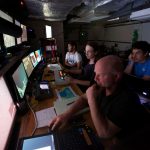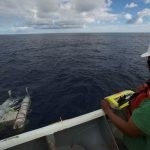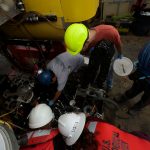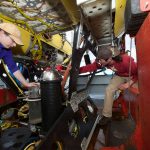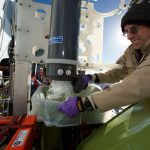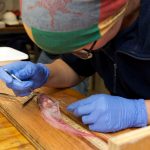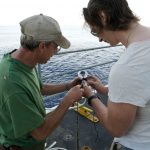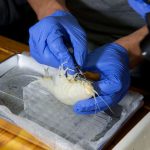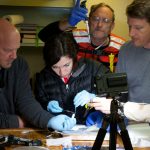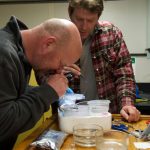- Mario Fernandez, Casey Machado, Tim Shank, and Santiago Herrera (left to right) in the Nereus control room during an 8-hour dive to 6,000 meters. (Photo by Ken Kostel, Woods Hole Oceanographic Institution)
- WHOI engineer Mario Fernandez remotely pilots Nererus on the surface close to the ship during recovery of the vehicle. (Photo by Ken Kostel, Woods Hole Oceanographic Institution)
- Once Nereus is safely on deck, a scrum of scientists collects samples from the vehicle’s payload basket. (Photo by Ken Kostel, Woods Hole Oceanographic Institution)
- Immediately after a dive, Casey Machado (left), Tom Lanagan, and other members of the Nereus team begin readying the vehicle for another dive. (Photo by Ken Kostel, Woods Hole Oceanographic Institution)
- Scripps Institution of Oceanography microbiologist Doug Bartlett collects a water sample from the hadal elevator to study the microbial diversity of the deep ocean. (Photo by Ken Kostel, Woods Hole Oceanographic Institution)
- University of Hawaii biology grad student Mackenzie Gerringer dissects one of two snailfish recovered from 7,000 meters. (Photo by Ken Kostel, Woods Hole Oceanographic Institution)
- R/V Thomas G. Thompson able-bodied seaman Brian Clampitt (left) instructs University of Aberdeen biologist Tom Linley in the art of splicing an eye into a line. (Photo by Ken Kostel, Woods Hole Oceanographic Institution)
- A supergiant amphipod (Alicella gigantea) brought up in the fish trap from 7,200 meters. (Photo by Ken Kostel, Woods Hole Oceanographic Institution)
- Whitman College undergraduate Gemma Wallace dissects the supergiant amphipod with a little help from (left to right) cruise Chief Scientist Tim Shank, Paul Yancey, Jeff Drazen, and Doug Bartlett. (Photo by Ken Kostel, Woods Hole Oceanographic Institution)
- WHOI’s Tim Shank and the University of Aberdeen’s Alan Jamieson attempt to identify some of the amphipods caught in the fish trap. (Photo by Ken Kostel, Woods Hole Oceanographic Institution)
The seafloor is getting farther from our keel with every dive. Tonight, Nereus goes to 8,000 meters (nearly five miles) with a full set of empty push cores and sample containers to fill. On a map of the Pacific Ocean seafloor, the Kermadec Trench is a thin line in the southwest corner. But when you zoom in, even at coarse detail the ship’s multibeam sonar reveals features that exceed the scale and grandeur of daily experience. Then you overlay the line marking a typical Nereus transect and you have to zoom in even further to make it something other than just a dot on the map.
There is no way to grasp the immensity and complexity of what’s down there because there is nothing up here with which to compare it. And we only have pinpricks of images and samples on which to hang our language and ideas to describe it. Moreover, scientists have only recently been able to peel back some of the overlying depths to paint, in broad strokes, an image of life in the deep, life that shares the planet with us and how it is able to survive on a part of the planet that is so alien to us. Part of the reason they are able to do so is because of the development of tools like Nereus.
Nereus went to 7,000 meters (4.2 miles) recently and took almost eight hours to get down and back. In the additional eight hours it spent on the seafloor, scientists watching rapt through a bank of monitors on the ship collected 16 sediment cores, specimens of seven organisms, and hours of ultra high-definition video that will be pored over for years to come. And yet it only traveled about one kilometer along a feature that is more than one thousand kilometers long and contains countless small habitats, cracks, and crevasses where things could hide and almost certainly are hiding.
Still, the sediment samples will almost certainly tell us something about the diversity of microbial life in the Kermadec, the animals collected will help quantify how much carbon is taken up by hadal organisms and how proteins manage to fold correctly under adverse conditions, and the imagery will give hard data about the sheer abundance and diversity of animals living on what was once thought to be a barren seafloor.
“The small number of samples we have beginning in the 1950s changed the way we think about trenches,” said Tim Shank, a biologist from the Woods Hole Oceanographic Institution and chief scientist on this NSF-funded mission. “I’m not surprised if I get surprised anymore about the remarkable diversity and adaptations of life in the deep sea. And I don’t think I’ve seen even the beginning of what’s down there.”
The hadal environment presents some of the foremost scientific questions we have today. Right now, we know so little about deep ocean trenches that we can ask some first-order, fundamental questions and apply some of what we know about the rest of the ocean to the deepest places.
The first, most basic, question we had was, “Is there life down there?” We’ve known since the 1950s that life has, in fact, evolved adaptations to most of the challenges that the deep ocean presents: high pressure, constant darkness, frigid temperatures, low or variable food supply. The questions now become how much life is there and how is so much diversity possible in the trenches given the challenges to life in the first place.
A tree in sunshine supports a remarkable diversity of life living in, on, and under it. All of this is fed by the sun at the most basic level. In the deep ocean, the only connection to the sun is the steady rain of organic material—mostly plankton and the remains of dead animals—falling from above. But most of this should be consumed by other life higher in the water column well before it reaches the bottom. Only about .01 percent of the organic matter leaving the surface should reach 5,000 meters. But there appears to be lots of life well below that so there must be plenty of food. How much is there and where is it coming from?
One of the problems inherent in our knowledge about trenches is that so far, exploration has focused on the very deepest places. We know now that places like Challenger Deep and the Mariana Trench in general may not be representative of all trenches. The Kermadec, for example, sits beneath extremely productive waters northeast of New Zealand, so it sees seasonal pulses of life driven by plankton blooms at the surface and nutrients from land. In other trenches closer to land than the Mariana, scientists have found coconuts and palm fronds.
There’s also a huge diversity of habitat and places for life to take hold. This means there is also likely to be a diversity of life forms and coping strategies that have evolved over millions of years. Unlocking the keys to those adaptations will help us not only understand life in the deep trenches better, it will also help us our place on Earth a little better.
“As a species, if we’re going to think about life on this planet and what it takes for us to continue to survive here, we better understand the adaptations and novelties of life in trenches,” said Shank.


